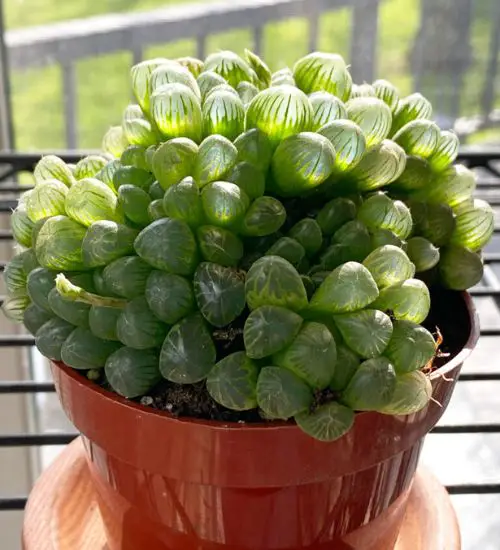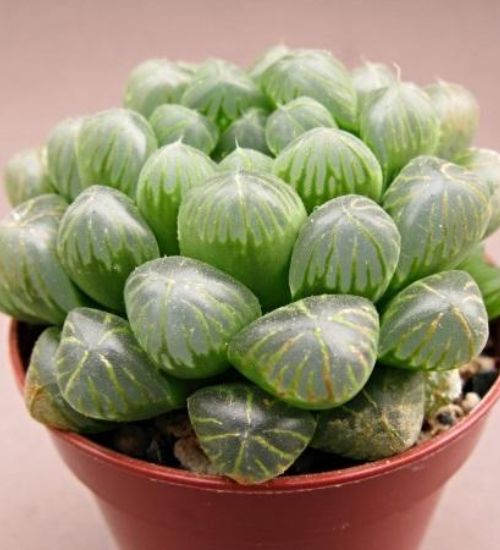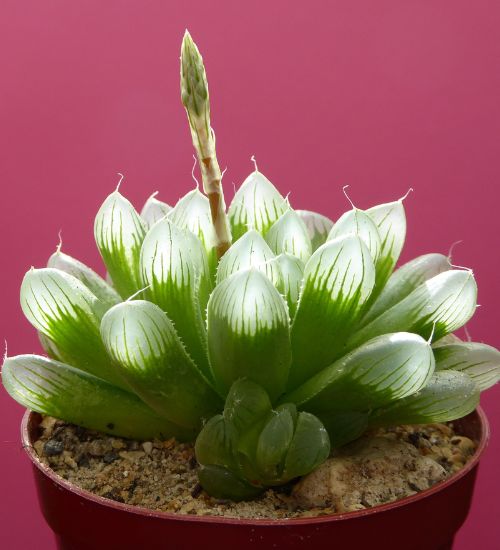Sun: Bright indoor light
Water: Below average watering needs for a succulent
Temperature: Zone 9a from 20° F to 25° F (-6.7 ° C to -3.9° C) to Zone 11b from 45° F to 50° F (7.2° C to 10° C)
Winter Survival: Not cold hardy
Propagation: offsets, seeds
Flower: in the Spring or Summer
Flower Type: white, pink
Toxic: Generally non-toxic to humans and animals
Dormant: summer
Space Requirement: Indoors
Common Problems: Plants may rot if overwatered
Where to buy Haworthia cooperi?
Basc Care for Haworthia cooperi
Watering
Watering for Haworthia cooperi is a simple task. It requires Below average watering needs for a succulent.
You can water your succulent more than often in extreme conditions but make sure that the soil is completely dry before watering your succulent again.
Fertilizing
Only feed this succulent during its active growing seasons which means winter. Use the right fertilizer applied in the right amounts. Applying half-strength balanced fertilizer every month or so is recommended for optimal results.
Do not fertilize during summer as the plant is dormant.
Sun & Location Requirements for "mini aloe plant"
Succulents need plenty of bright, indirect light. Your Haworthia cooperi is no exception! In order to thrive, "mini aloe plant" needs to be in a spot that gets direct sunlight for at least part of the day. If you don't have access to natural sunlight indoors, consider investing in an LED grow-light or other artificial lights to mimic sunlight.
As per this succulent profile, it is only able to stay healthy when the environment temperature is above the range of zone 9a from 20° F to 25° F (-6.7 ° C to -3.9° C).
When temperatures drop below freezing, it is important to take precautions to protect Haworthia cooperi from the cold. Insulating and providing adequate drainage for the plant are key elements in helping it survive winter weather. Wind and sun exposure should also be minimized to prevent frost damage.
Any succulents in the group will only need minimal space to grow. You can place your pot at your table or window. Outdoors is also a nice idea to put your pot.
Haworthia cooperi also benefits from some indirect light throughout the day as well, so make sure you give it enough space to soak up light without becoming too exposed to heat.
Propagation
Propagating with offsets is a great way to get more plants from the same mother plant. All you have to do is cut away an offset and pot it in soil, and soon enough you’ll have a brand-new Haworthia cooperi!
Growing Haworthia cooperi from seeds is an easy and economical way to produce more plants. Identify a healthy seed by its plumpness, dark color and slightly sticky texture. Once the potting mix has been pre-mixed with well-draining soil, sow the seeds evenly and press lightly into the surface. To ensure germination, keep the container in bright but indirect light and mist the soil gently with a spray bottle.
Toxicity

Haworthia cooperi is generally non-toxic to humans and animals. However, it is important to be aware that certain parts of the plant may contain toxins which can cause mild skin irritation. It is advised that you keep the plants away from small children or pets, as they may unknowingly ingest them and suffer ill effects.
Haworthia cooperi is generally non-toxic to humans and animals. However, the plant may contain certain toxins which can cause mild skin irritation if it is ingested or comes in contact with skin. Therefore, it is important to keep the plant away from children and pets for safety reasons.


